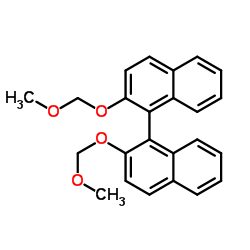142128-92-5
| Name | (S)-2,2'-Bis(methoxymethoxy)-1,1'-binaphthalene |
|---|---|
| Synonyms |
(R)-2,2'-Bis(methoxymethoxy)-1,1'-binaphthyl
(S)-2,2'-BIS(METHOXYMETHOXY)-1,1'-BINAPHTHYL 2,2'-Bis(methoxymethoxy)-1,1'-binaphthalene 2,2'-BIS(METHOXYMETHOXY)-1,1'-BINAPHTHYL (S)-(-)-2,2′-Bis(methoxymethoxy)-1,1′-binaphthyl 1,1'-Binaphthalene, 2,2'-bis(methoxymethoxy)- (P)-2,2 |
| Density | 1.2±0.1 g/cm3 |
|---|---|
| Boiling Point | 477.8±45.0 °C at 760 mmHg |
| Melting Point | 92-96ºC(lit.) |
| Molecular Formula | C24H22O4 |
| Molecular Weight | 374.429 |
| Flash Point | 126.2±35.6 °C |
| Exact Mass | 374.151794 |
| PSA | 36.92000 |
| LogP | 4.57 |
| Vapour Pressure | 0.0±1.1 mmHg at 25°C |
| Index of Refraction | 1.630 |
|
Section 1: Product Identification Chemical Name:(S)-(-)-2,2'-Bis(methoxymethoxy)-1,1'-binaphthyl, 98% CAS Registry Number:142128-92-5 Formula:C24H22O4 EINECS Number:none Chemical Family:organic alcohol Synonym:(S)-(-)-2,2'-Bis-methoxymethoxy-[1,1']binaphthalenyl
Section 2: Composition and Information on Ingredients IngredientCAS NumberPercentACGIH (TWA)OSHA (PEL) Title compound142128-92-5100%no datano data Section 3: Hazards Identification Emergency Overview:Dust is irritating to the respiratory tract, skin, eyes. May be harmful if swallowed. Primary Routes of Exposure:Ingestion, eyes, inhalation Eye Contact:Causes mild to moderate irritation of the eyes. Skin Contact:Causes slight to mild irritation of the skin. Inhalation:Dust is irritating to the nose, mucous membranes and respiratory tract. Ingestion:No specific information is available on the physiological effects of ingestion. Acute Health Affects:Irritating to skin, eyes and respiratory tract. Chronic Health Affects:No information available on long-term chronic effects. NTP:No IARC:No OSHA:No SECTION 4: First Aid Measures Immediately flush the eyes with copious amounts of water for at least 10-15 minutes. A victim may need Eye Exposure: assistance in keeping their eye lids open. Get immediate medical attention. Wash the affected area with water. Remove contaminated clothes if necessary. Seek medical assistance if Skin Exposure: irritation persists. Remove the victim to fresh air. Closely monitor the victim for signs of respiratory problems, such as difficulty in Inhalation: breathing, coughing, wheezing or pain. In such cases seek immediate medical assistance. Seek medical attention immediately. Keep the victim calm. Give the victim water (only if conscious). Induce Ingestion: vomiting only if directed by medical personnel. SECTION 5: Fire Fighting Measures Flash Point:no data Autoignition Temperature:no data Explosion Limits:no data Extinguishing Medium:dry chemical, carbon dioxide, water or foam. If this product is involved in a fire, firefighters should be equipped with NIOSH approved positive pressure Special Fire Fighting Procedures: self-contained breathing apparatus. Hazardous Combustion andIf involved in a fire this material may emit toxic organic fumes, carbon monoxide and carbon dioxide. Decomposion Products: Unusual Fire or Explosion Hazards: No unusual fire or explosion hazard. SECTION 6: Accidental Release Measures Small spills can be mixed with vermiculite, sodium carbonate or other suitable non-combustible adsorbent and Spill and Leak Procedures: swept up. SECTION 7: Handling and Storage Handling and Storage:Store the material in a tightly sealed container in a cool, dry place. SECTION 8: Exposure Controls and Personal Protection Eye Protection:Always wear approved safety glasses when handling a chemical substance in the laboratory. Skin Protection:Wear protective clothing and gloves. Ventilation:If possible, handle the material in an efficient fume hood. If ventilation is not available a respirator should be worn. The use of respirators requires a Respiratory Respirator: Protection Program to be in compliance with 29 CFR 1910.134. Ventilation:If possible, handle the material in an efficient fume hood. Additional Protection:No additional protection required. SECTION 9: Physical and Chemical Properties Color and Form:white powder Molecular Weight:374.43 Melting Point:100-103° Boiling Point:no data Vapor Pressure:no data Specific Gravity:no data Odor:not determined Solubility in Water:slightly soluble SECTION 10: Stability and Reactivity Stability:air and moisture stable Hazardous Polymerization:no hazardous polymerization Conditions to Avoid:none Incompatibility:oxidizing agents Decomposition Products:carbon monoxide, carbon dioxide and organic fumes. SECTION 11: Toxicological Information RTECS Data:No information available in the RTECS files. Carcinogenic Effects:no data Mutagenic Effects:no data Tetratogenic Effects:no data SECTION 12: Ecological Information Ecological Information:No information available SECTION 13: Disposal Considerations Disposal:Dispose of according to local, state and federal regulations. SECTION 14: Transportation Shipping Name (CFR):Non-hazardous Hazard Class (CFR):NA Additional Hazard Class (CFR):NA Packaging Group (CFR):NA UN ID Number (CFR):NA Shipping Name (IATA):Non-hazardous Hazard Class (IATA):NA Additional Hazard Class (IATA):NA Packaging Group (IATA):NA UN ID Number (IATA):NA SECTION 15: Regulatory Information TSCA:Not listed in the TSCA inventory. SARA (Title 313):Title compound not listed. Second Ingredient:none SECTION 16 - ADDITIONAL INFORMATION N/A |
| Symbol |


GHS05, GHS09 |
|---|---|
| Signal Word | Danger |
| Hazard Statements | H318-H410 |
| Precautionary Statements | P273-P280-P305 + P351 + P338-P501 |
| Personal Protective Equipment | dust mask type N95 (US);Eyeshields;Gloves |
| Hazard Codes | Xi,N |
| Risk Phrases | R41 |
| Safety Phrases | S26 |
| RIDADR | UN 3077 9/PG 3 |
